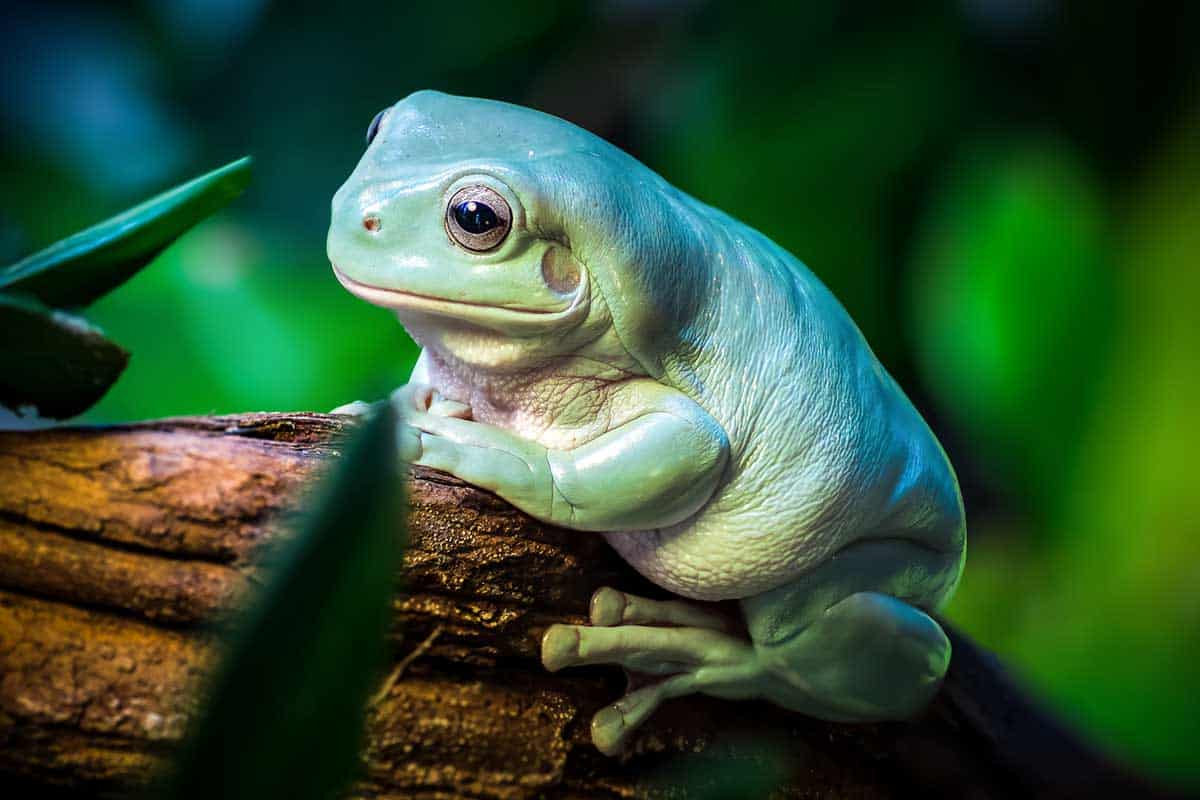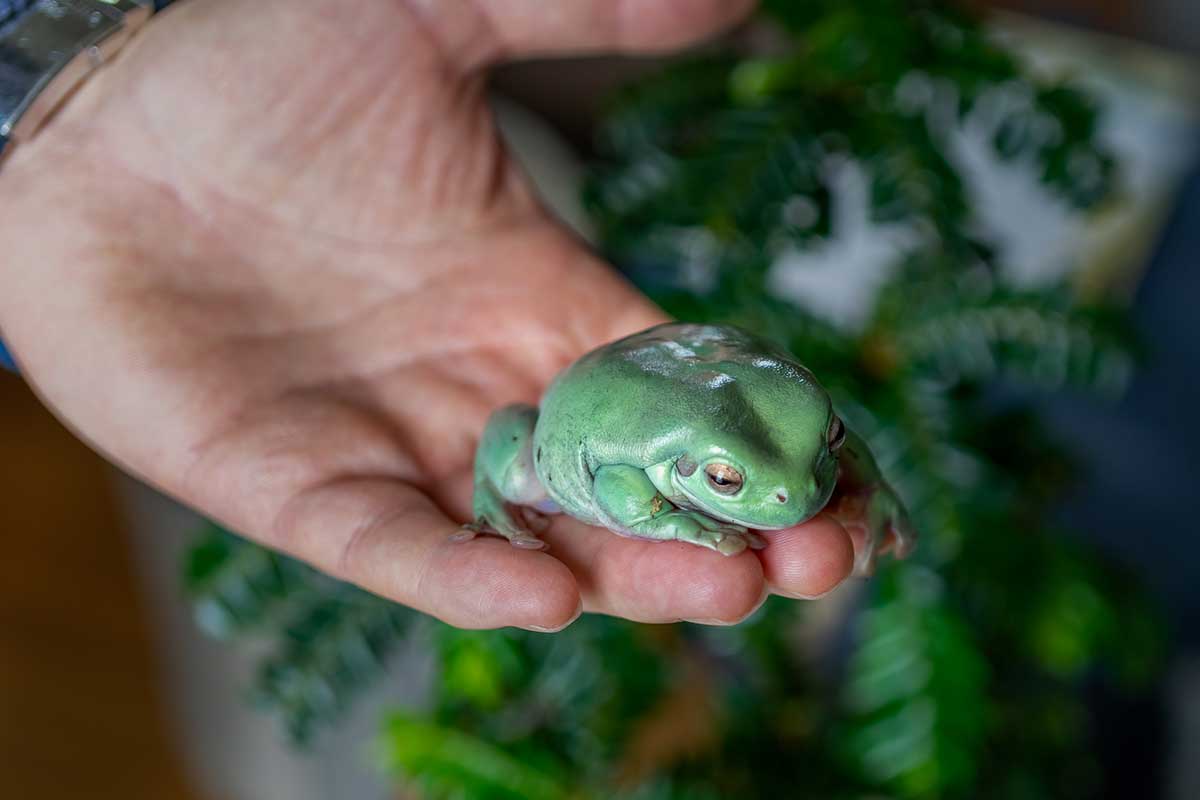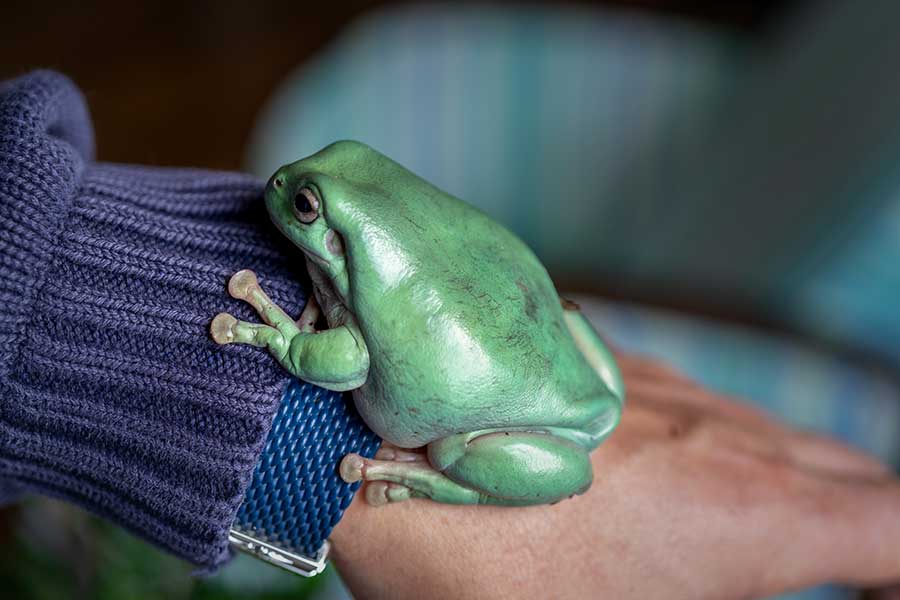
White’s tree frog care is surprisingly straightforward, which makes them great entry-level frogs. Also known as dumpy frogs, these arboreal frogs are beautiful to look at and full of character.
To find out how to properly care for your White’s tree frog, read on!
Where Do White’s Tree Frogs Come From?
The White’s tree frog (Litoria caerulea) is native to Australia, Indonesia, New Zealand, New Guinea. In the wild they can be found living in trees, eating bugs and drinking rain water that collects in leaves.
The White’s tree frog gets its name from John White who first discovered the little green frog in 1790. It’s also referred to as the Australian green tree frog or the Dumpy tree frog.
White Tree Frog Lifespan
White’s tree frogs can live up to 20 years in captivity. In the wild it’s more common for them to have a lifespan of 7-10 years old. That’s because frogs do not have any real defense other than camouflage, so their lifespan in the wild is significantly shorter.
White’s Tree Frog Size
White’s tree frogs are medium-to-large-sized frogs. They grow to roughly four inches on average, with males being slightly smaller than females.

Behavior and Temperament of White’s Tree Frog
White’s tree frogs are very docile, do not jump a lot, and are very calm. They will laze about on their perches during the day or suction themselves to the sides of their enclosure. So you’ll have plenty of opportunity to observe them.
White’s tree frogs are nocturnal so they liven up and move around a lot more at night. Although they are reluctant to jump, they do when the mood strikes them. It is something to behold as their large bodies move silently and gracefully through the air.
White’s Tree Frog Appearance
White’s tree frogs are also known as Dumpy tree frogs because of their chunky, round bodies. Their skin has a waxy coating and they have dopey-looking smiles, and big eyes that stick out of the sides of their heads.
White’s tree frogs are usually white on their bellies and teal-blue to bright green color on top, although the exact color varies from one frog to the next. There are also certain morphs, such as “Snowflakes,” with markings like large white splotches or little white speckles over their backs!
At night, something truly amazing happens to these unique frogs: their color appears to change. They become slightly purplish to blend in better with their surroundings. That’s because they are nocturnal creatures, and they have adapted this ability to help them hunt.
White’s Tree Frog Enclosure Setup
White’s tree frogs are arboreal (which means they live in trees), so they need an enclosure that is taller than it is long. Even though they are a bit lazy and do not move around that much, they still need space to climb.
Read on to learn about the ideal White’s tree frog tank setup.
Equipment For White’s Tree Frog Keeping
- Glass
terrarium - Water bowl
- UVB bulb
- Ceramic heat emitter
- Heat mat
- Humidity gauge / hygrometer
- Decor (e.g. artificial plants, climbing perches like branches and vines)
- Substrate (e.g. pieces of bark, large coconut chips, coconut fiber)
- Spray bottle or automatic misting system
- Calcium powder
Enclosure Size
The minimum size for a White’s tree frog’s enclosure is 10 gallons. However, a 20-gallon
Additionally, you must ensure the enclosure has a lid that can be locked in place, as frogs are escape artists!
Enclosure Type
White’s tree frogs have tiny suction pads on their feet that allow them to climb vertically. This means they need a surface they can easily suction onto, such as glass or plexiglass.
Wooden enclosures will start to mold and rot very quickly, as the humidity levels in the enclosure must stay very high for White’s tree frogs.
Mesh-sided enclosures are not a good option for White’s tree frogs because your frog will not be able to suction onto the mesh, and the mesh provides too much airflow, which will decrease the amount of humidity in the enclosure.
Substrate
Substrate is essentially just the ‘stuff’ at the bottom of the enclosure. It plays an important role because it helps retain moisture and keep the humidity levels in the enclosure stable.
Even though White’s tree frogs are arboreal, they still do go down to the floor of their enclosure fairly often, which means their substrate should be comfortable and able to retain lots of moisture and heat.
Orchid bark, large coconut chips, coconut fiber, pieces of cork bark, and forest floor are all good natural substrates to go for. If you find that the humidity levels are not holding throughout the day or that the enclosure is drying out very quickly, you can even add some sphagnum moss.
To help maintain humidity levels in the enclosure, add some live plants potted in terracotta pots. These plants should be nontoxic and sturdy enough to withstand the weight of your White’s tree frog. If you don’t want to bother with live plants, you’ll need to mist the enclosure often throughout the day.
Decorations
Adding climbing perches like branches and vines to the enclosure is essential because White’s tree frogs love to climb. Branches and plants also provide places for your White’s tree frog to hide when they are stressed or scared. Without these quiet, secluded places, your frog has nowhere to de-stress and recuperate which could lead to ill health and illness.
There should be perches that run horizontally across the enclosure as well as some that are more angled and almost vertical. Remember, you are trying to simulate natural trees and branches in the enclosure.
All of the perches must be secured properly, as they will need to bear the weight of your chubby frog! You can also use PVC pipes as perches. These will, however, need to be cleaned thoroughly of any coating before being introduced into the environment.

You can also get fake foliage, cork bark, and other forms of plant cover to add to the enclosure to make it look more natural. You could even add branches from your own garden! If you choose this option, just make sure you disinfect the branches first.
To do this, you will need to boil them in water for at least 10 minutes. Once they have been boiled, place them on a clean baking tray and place them in the oven on low heat with the door slightly open to dry them out completely.
It is imperative that all decorations are free of any chemicals, toxins, or contaminants that could make your frog sick.
White Tree Frog Temperature
Your White’s tree frog needs a gentle temperature gradient in the enclosure. This means they should be able to move from a warm spot on one side of the enclosure to a cool spot on the other side.
The easiest way to do this is to create a temperature gradient with a simple heat bulb at the top of the enclosure. This will result in the top of the enclosure being hotter than the bottom. As your frog needs to heat up or cool down, it can move to the different locations inside of the enclosure.
Make sure the
Remember, all lights will need to be turned off at night (even red ones), which means the overall temperature will fall. Keep a careful eye on this with a
If nighttime temperatures drop too much, then you will have to use a small under-tank heating pad to maintain the lower temperature at night. These mats have inbuilt thermostats to regulate the temperature.
White’s Tree Frog Humidity
The enclosure’s humidity should always sit between 70% and 80%. To maintain the humidity, you will need to mist the enclosure daily. This is quite a high level of humidity to maintain, so having real plants and sphagnum moss in the enclosure will help.
You can also use an automatic misting system for the enclosure. This will help keep the enclosure’s humidity levels consistent.
Be sure to also put a hygrometer in the enclosure to monitor the humidity levels. You can get combined thermometers/hygrometers which reduces the number of technical things you need in the enclosure.
Lighting
Arboreal species do not need a huge amount of UVB light; however, they still need some. A small 5% to 6% UVB light fitted into the enclosure roof is ideal.
Your White’s tree frog also needs to have a normal photocycle. This means they need some hours of light and some hours of dark every day. The ideal ratio is 12 to 14 hours of light and 10 to 12 hours of dark.
During the dark cycle, all lights must be turned off. You can use a small light outside of the enclosure if you wish to observe them at night. Just make sure they still have several hours of complete darkness.
White’s Tree Frog Diet
Food
White’s tree frogs are carnivorous, so they only eat meat. Generally, this meat will come from feeder insects and worms. Variety is key to a healthy, nutritious, and tasty diet.
They should be fed two to three times a week. During the feeding, let your frog eat as many food items as they want for 30 minutes. This will ensure they are fed properly (but not too much, which can quickly lead to obesity).
Staple food items include:
- Crickets
- Dubia roaches
- Grasshoppers
- Mealworms
- Phoenix worms
You can also occasionally treat your froggy to a little juicy and fatty snack in the form of waxworms, butter worms or small pinky mice!
Food items should be no larger than the space between your frog’s eyes. If they are too large, they can cause choking or impaction in the intestine. All insects should be fed or “gut-loaded” with
Once to twice a week, you will need to lightly dust the insects to be fed that day with some
Water
In addition to misting the enclosure regularly with water, you’ll also need to provide your frog with a source of clean water to drink.
There should be a large, shallow, non-porous water dish in the enclosure that can fit your frog’s whole body into it. Make sure you refresh it daily with dechlorinated water (fresh tap water is generally fine). Your frog may defecate into the water often, so check and clean that bowl regularly!
Common Health Issues for White’s Tree Frogs
White’s tree frogs are very easy going pets but they can still suffer from certain health issues if not looked after properly. The most common ailments include:
Dry and Infected Skin
Just like the red-eyed tree frog, White’s tree frogs are prone to skin issues. When their skin dries out too much, it develops tiny yet irritating microtears. These tears in the skin allow bacteria and fungus to get in and can develop into various types of skin infections. It is essential that the humidity levels in the enclosure are carefully maintained so you keep your frog’s skin moist.
Obesity
White’s tree frogs are chubby-looking creatures naturally, which is why it is easy to overfeed them.
Even though a chubby frog may look very cute, obesity puts their organs under a huge amount of stress and can lead to organ failure. It’s therefore crucial that you don’t overfeed them.
FAQs About White’s Tree Frogs
White’s tree frogs are one of the best amphibians for a beginner, but they may be too much of a commitment for many children.
Caring for any amphibian (even a beginner one) is still a time-consuming task that requires concentration and attention to detail, as they are more sensitive than other animals to small changes in their environment.
Remember these frogs live for 10 to 15 years, so they are a serious commitment and won’t be suitable for all children or teenagers. If you are looking for a unique pet for your kids that is a little more exotic than a dog or a cat, check out our list of reptiles that are better suited to children!
You should only handle your White’s tree frog when it is absolutely necessary.
White’s tree frogs are amphibians, so they have permeable / porous skin. This skin allows them to do many cool things, like helping them breathe! Permeable skin allows things like gas and liquids to pass through it. This means anything that comes into contact with the skin of an amphibian will pass through it and into its system.
The natural oils and salt on human skin are damaging to amphibians, as are many of the toxins and chemicals we come into contact with daily. Sadly, even brief handling poses a serious risk to your White’s tree frog.
In addition to their skin permeability, their bones are not very strong, and they can suffer from injuries caused by rough handling.
When you need to handle your White’s tree frog to move them around or clean their enclosure, you will need to be very careful. Before handling them, always clean your hands with a mild soap and rinse thoroughly to ensure no soap is left on them.
White’s tree frogs are one of the few social frogs! These frogs will happily live in an enclosure with other White’s tree frogs. However, they can become stressed if they feel cramped.
Therefore, it is important to make sure there is enough space for all of the frogs in the enclosure. For every frog you add to the enclosure, the enclosure should be upsized by two to five gallons.
Additionally, all of the frogs should be around the same size. If there is a size disparity, the larger frogs will gang up on and potentially even try to eat the smaller frogs.
You will also need to ensure there is more than enough food to go around at feeding time so the more submissive frogs are not bullied into starvation. Finally, make sure there is at least one large perch per frog in the enclosure. It should be the same distance to the UVB light so all of your frogs can bask comfortably.
White’s tree frogs are perfectly happy by themselves so it’s fine to just keep one frog. Remember, the more frogs you have the more space you need so if you only have room for a 20 gallon tank then stick with one White’s tree frog.
You don’t need a heat mat in your White’s tree frog enclosure providing you have a
Yes, White’s tree frogs need a
Hop Away
White’s tree frogs are well-loved and popular pets, and their care is simple to master once you get all of the details down.
You’ll get hours of entertainment watching your White’s tree frog walk around, hop from perch to perch, and munch their way through their meals.



